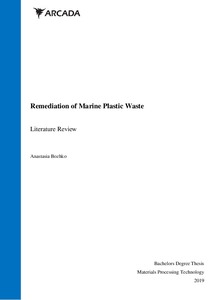Remediation of Marine Plastic Waste
Bozhko, Anastasia (2019)
Bozhko, Anastasia
2019
All rights reserved. This publication is copyrighted. You may download, display and print it for Your own personal use. Commercial use is prohibited.
Julkaisun pysyvä osoite on
https://urn.fi/URN:NBN:fi:amk-2019052913320
https://urn.fi/URN:NBN:fi:amk-2019052913320
Tiivistelmä
Plastics Production volumes have soared globally over the past 70 years. Rapid production and population growth coupled with inefficient waste management and plastic’s slow degradation rate resulted in significant contamination of the environment. The World Ocean is becoming increasingly polluted with estimated 244 000 metric tons of plastics debris having reached the ocean since the 1950s. In our days, plastics waste is generated by almost every known economic sector at virtually each step of the product’s lifecycle, leading to infinite possibilities for waste to become marine litter. Structured knowledge about sources, pathways, impacts and fate of plastics litter is essential for addressing the problem of marine pollution. This work is designed as literature review of a broad topic of plastics marine debris. The main goal is to collect information from multiple sources and condense accumulated knowledge into summaries related to plastics pollution. The fisrt chapter investigates the sources and pathways of marine debris. The next section investigates how plastics can pose a threat to the marine environment. The third section looks at ways of preventing marine pollution – at source, during lifecycle and after it becomes marine litter. Ways of reducing demand for pristine material and prolonging useful life of already existing objects are reviewed. The overall finding is that although scale of the problem is alarming, we have all the tools, knowledge and energy to minimize generated waste and change the trajectory of ocean pollution. For this to happen, effective upstream measures need to be taken such as improving waste management infrastructure, changing consumer behaviour, seeking sustainable material alternatives and thoughtful law enforcement. Unfortunately, the ocean will stay polluted for a long time as majority of the existing marine debris is submerged and can not be recovered in effective manner.
